Boxed In – Live Art and Confinement
Responding to the social conditions and lived experiences of the Covid-19 lockdown, LADA is compiling a series of reference lists of writings and films which draw attention to examples of historic and contemporary Live Art practice that produce states and encounters that are in someway akin to, or speak to, some of the experiences or issues of lockdown. These lists are imagined as resources where artists, researchers and curious folk might start their own investigations into the relationships between art making and periods of isolation, distancing, stasis and contagion.
This list, entitled Boxed In reflects some of the ways in which Live Art operates in relationship to issues and conditions of confinement.
Selina Thompson
In February 2016, two artists got on a cargo ship, and retraced one of the routes of the Transatlantic Slave Triangle, from the UK to Ghana to Jamaica, and back. Upon returning from the journey, Selina Thompson made salt., a work for theatres considering grief, home, Afro-pessimism, the Black Atlantic, the forgetting of the UK’s colonial history and the impact that has on the daily life of Caribbean communities in the UK today. Through salt. Selina confronts the oppressive power dynamics of contemporary capitalism and its attendant racism and misogyny, rendered in the hyper-locality of the cargo ship.
There are extensive reviews and interviews of salt. available online and the text has been published by Faber Drama and is available from Unbound.
Selina was a contributor to Last Night Art Saved My Life, an event at LADA considering how art can function as a survival strategy. Selina is LADA’s thinker-in-residence during our Managing The Radical project.
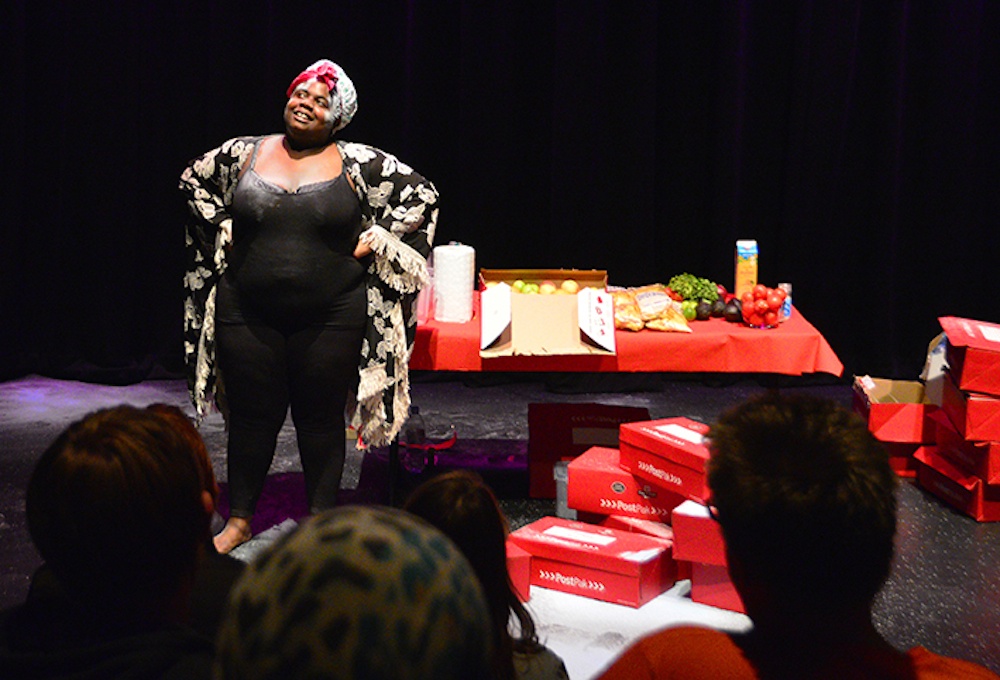 Selina Thompson, 'The Stilton Mash' (credit: Andrew Whittuck)
Selina Thompson, 'The Stilton Mash' (credit: Andrew Whittuck)
Guillermo Gómez-Peña and Coco Fusco
In Couple in the Cage: Two Undiscovered Amerindians Visit the West (1992), Guillermo Gómez-Peña and Coco Fusco appeared in a series of public interventions as two caged “Guatinaui Indians,” members of a fictional “newly discovered” tribe who had agreed to be displayed at malls and museums around the world. The work intervened in all kinds of critical and cultural dialogues: institutional museum critique, post-colonial debate, problematic representations of cultural otherness, and para/fictional art.
Guillermo is one of LADA’s Patrons and has contributed to numerous LADA programmes including Live Culture at Tate Modern n 2003. He recently made his archive available online. During the Covid-19 pandemic, he has kept an online stream of consciousness blog entitled How to survive the apocalypse. There is extensive documentation of Coco Fusco’s work on her website. Both artists have published extensively – online and in print – with a number of titles available on Unbound.
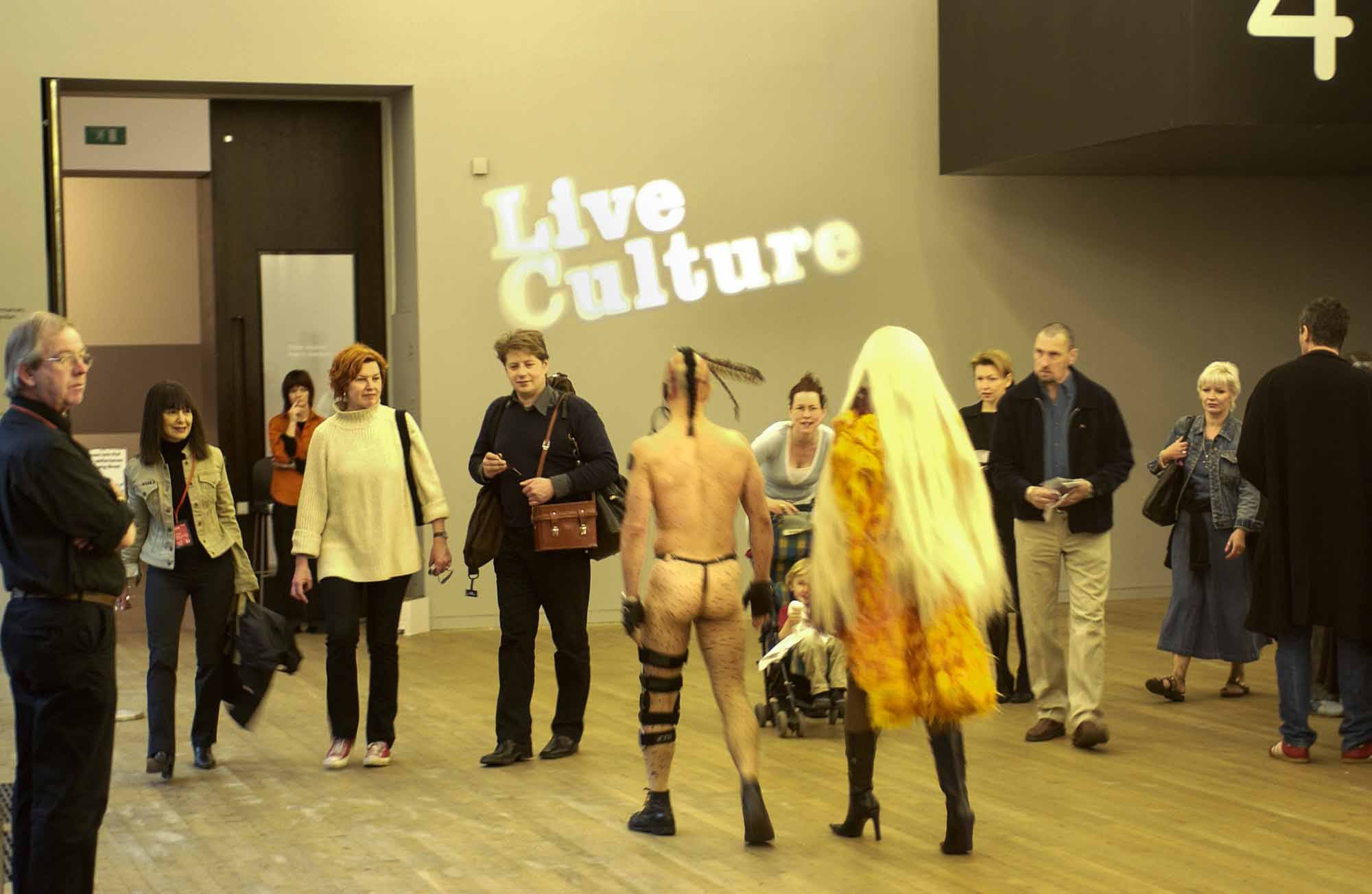 La Pocha Nostra, Ex-Centris (A Living Diorama of Fetish-ized Others), 2003, Tate Modern. Image credit Manuel Vason. LADA Projects, Live Culture at Tate Modern
La Pocha Nostra, Ex-Centris (A Living Diorama of Fetish-ized Others), 2003, Tate Modern. Image credit Manuel Vason. LADA Projects, Live Culture at Tate Modern
Ansuman Biswas
In 1998, Ansuman Biswas practiced a Vipassana meditation inside a soundproof black box for ten days in South London Gallery. This work, entitled CAT, arose “from the meeting of two images. One, from the world of physics, of Schrödinger’s cat. The other, from various contemplative traditions, of the hermit in a cell” and considered the relationship between a science of ideas and a science of desires and fears.
Ansuman has published his own writing about CAT on his website, and further writing by Silvia Battista was published in Posthuman Spiritualities in Contemporary Performance.
Ansuman has contributed to a wide range of LADA projects over the years, including Louder Than Bombs at Stanley Picker Gallery in 2010, The Art of Noises at Latitude Festival in 2015, KAPUTT: Academy of Destruction at Tate Exchange in 2017, and Animals of Manchester (including Humanz) for Manchester International Festival in 2019.
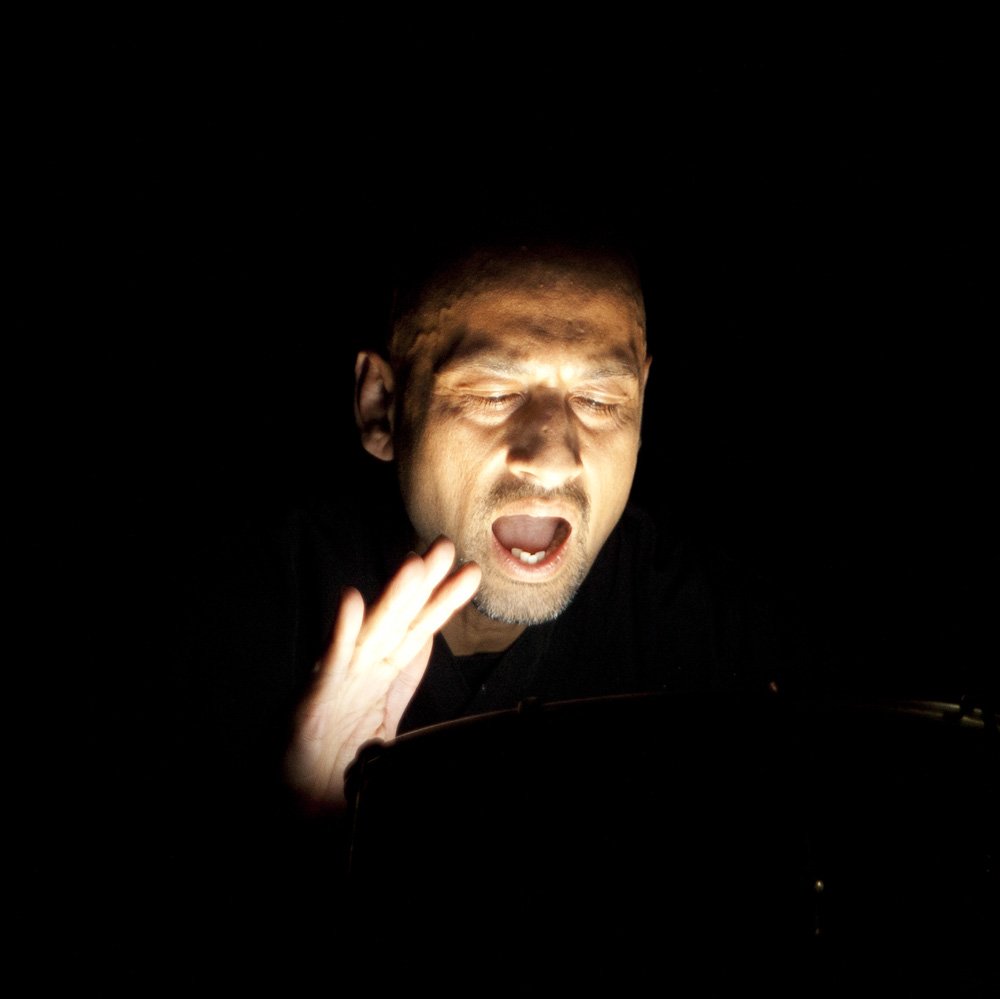 Ansuman Biswas, photo by Holly Revell
Ansuman Biswas, photo by Holly Revell
Tehching Hsieh
In the late 70s and early 80s artist and LADA Patron Tehching Hsieh undertook a series of six year-long performances. Committing to a series of deceptively simple instructions and restrictions, such as living outside for a year, or punching a time clock on the hour every hour for 365 days, these works seem to push at the boundaries of the quotidian imagination. In the first One Year Performance (1978/79) Hsieh lived inside a cell in his studio. The action was documented, with visitors permitted to attend the performance on one or two days each month. One Year Performance was notarised and certified by an attorney, Robert Projansky.
Statement
I, Sam Hiseh, plan to do a one year performance piece, to begin on September 30, 1978.
I shall seal myself in my studio, in solitary confinement inside a cell-room measuring 11’6” X 9’ X 8’.
I shall NOT converse, read, write, listen to the radio or watch television, until I unseal myself on September 29, 1979.
I shall have food every day.
My friend, Cheng Wei Kuong, will facilitate this piece by taking charge of my food, clothing and refuse.
In 2009, LADA co-published with MIT Press Out of Now: The Lifeworks of Tehching Hsieh (eds. Adrian Heathfield and Tehching Hsieh), and in 2018 hosted a conversation between Hsieh and artist Li-E Chen, a film of which may be viewed here. Hsieh’s work has been presented twice through LADA Screens – documentation of One Year Performance 1981-1982 (Outdoor Piece) and Outside Again, a documentary on his work. Ash Dilks has written a short text on Hsieh’s work, and there is extensive critical and press content available online.
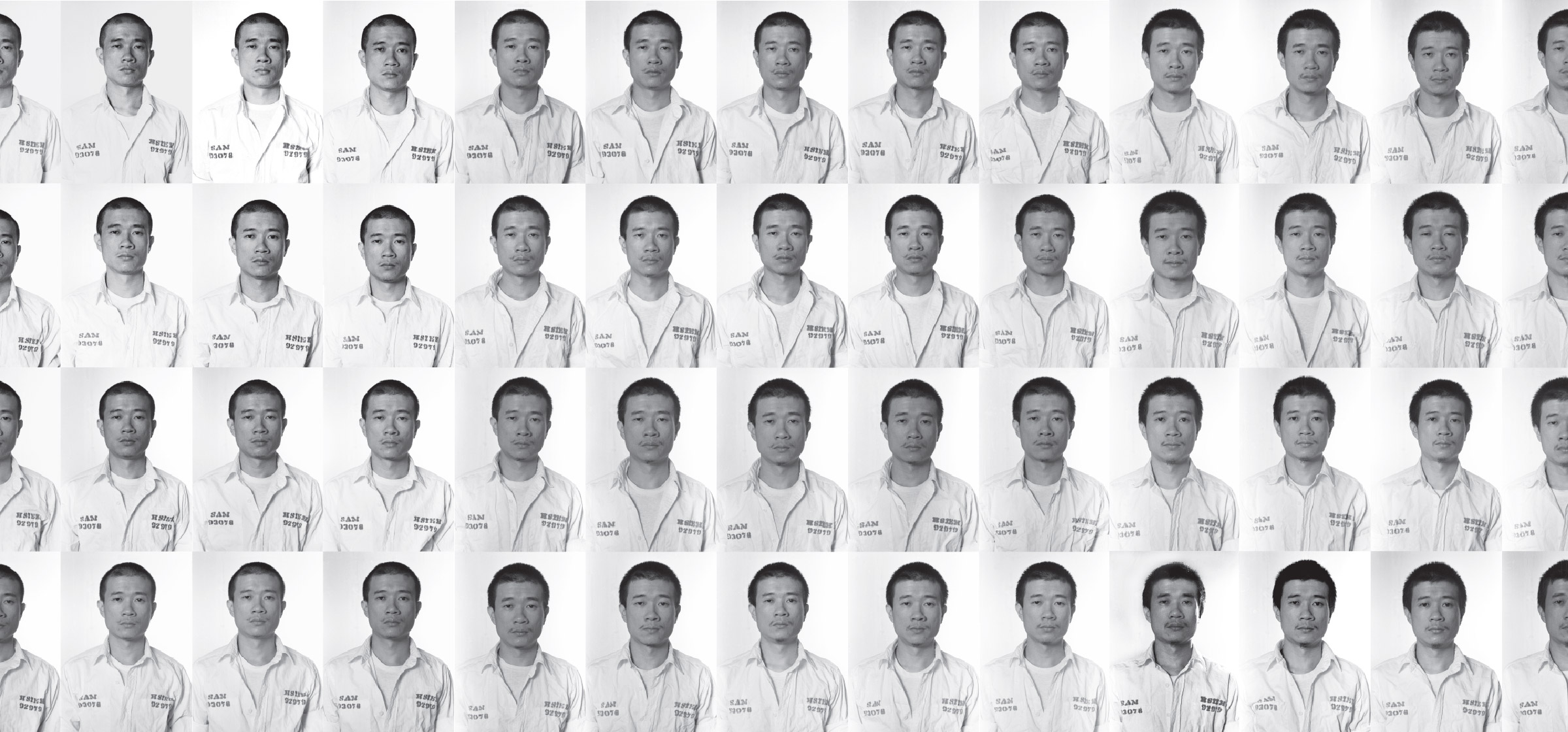 ONE YEAR PERFORMANCE 1978 - 1979 (Cage Piece), Tehching Hsieh. LADA Publishing: Out of Now, The Lifeworks of Teching Hsieh, Ed. Adrian Heathfield, 2009.
ONE YEAR PERFORMANCE 1978 - 1979 (Cage Piece), Tehching Hsieh. LADA Publishing: Out of Now, The Lifeworks of Teching Hsieh, Ed. Adrian Heathfield, 2009.
 Out of Now, The Lifeworks of Teching Hsieh, Ed. Adrian Heathfield, 2009
Out of Now, The Lifeworks of Teching Hsieh, Ed. Adrian Heathfield, 2009
Martin O'Brien
Martin O’Brien works across performance, writing and video art, utilising physical endurance, long duration and pain-based practices to examine what it means to be born with a life-shortening disease. Between 2010 and 2012 Martin ran a series of durational, immersive workshops considering the role of preparation and altered states in endurance performance. During these workshops, participants were confined to the workshop venue, eschewing phones, technology and showers.
The first of these workshops, presented as Altered States, was part of LADA’s DIY programme in 2010; the second was presented at ]performance s p a c e[ during Martin’s Regimes of Hardship residency. LADA commissioned Martin’s Mucus Factory for our Access All Areas programme in 2011. In 2018, LADA published Survival of the Sickest – the first book dedicated to Martin’s practice.
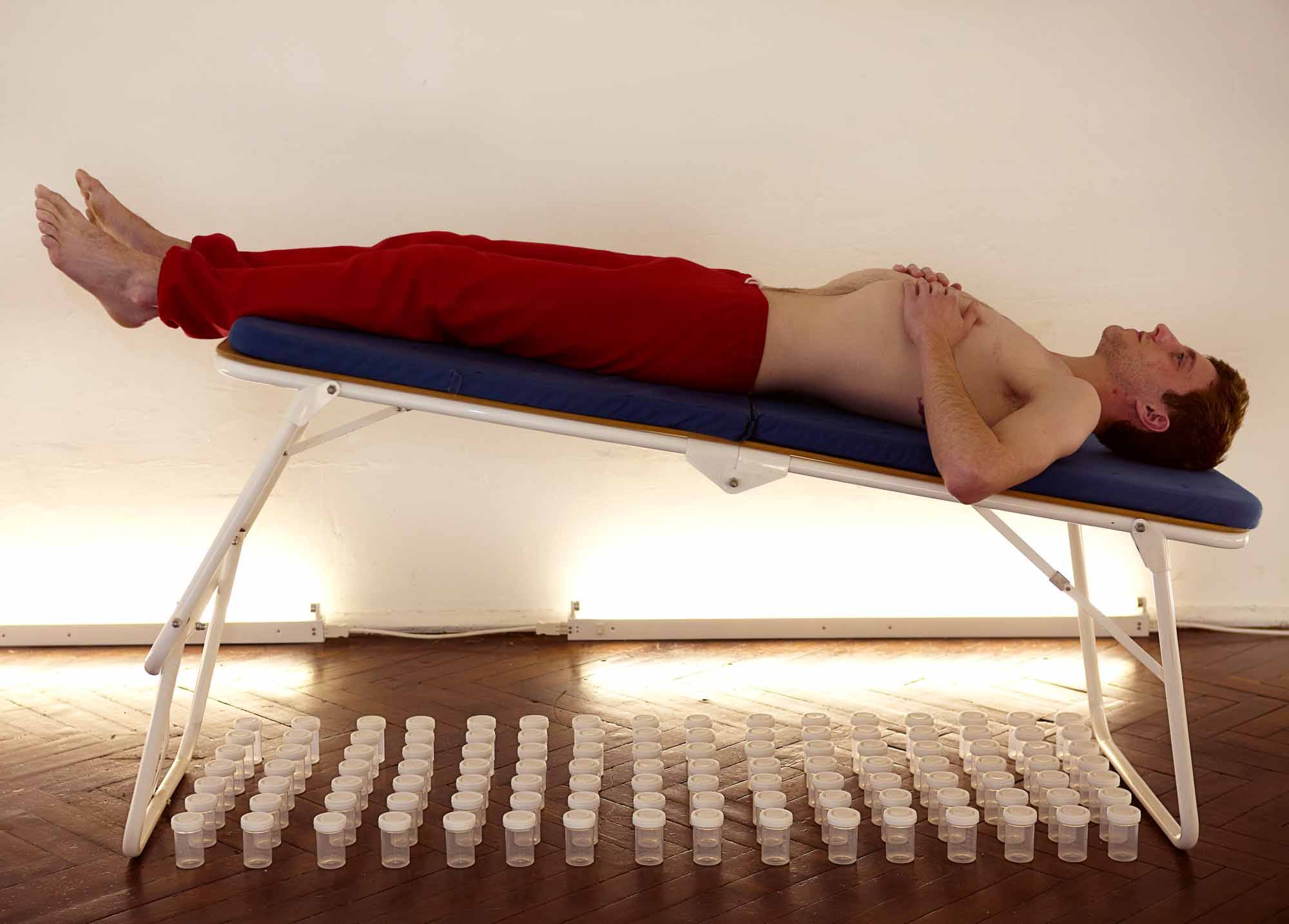 Martin O’Brien, Mucus Factory, 2011, London. Image credit Manuel Vason. LADA Research and Projects, Restock Rethink Reflect Two on Live Art and Disability and Access All Areas (London and New York)
Martin O’Brien, Mucus Factory, 2011, London. Image credit Manuel Vason. LADA Research and Projects, Restock Rethink Reflect Two on Live Art and Disability and Access All Areas (London and New York)
Skip Arnold
Active since the early 1980s, the actions of American artist Skip Arnold can be understood as a sustained attempt to subvert subjectivity, meaning or value in the service of becoming an object. Proclaiming his sole interest as “the image and nothing else”, Arnold utilises long duration and repetition to produce what Dominic Johnson describes as “bluntly mimetic embodiments of a statue, gargoyle, scarecrow, fountain, or freight.” In Freight (1993) Arnold had himself placed inside a freight box and shipped, over several days, from Linz, Austria to Unfair Art Fair in Cologne, Germany, and during, the 1999 Gramercy International Contemporary Art Fair in New York, he spent nine hours a day in a hotel shower.
LADA hosted An Evening with Skip Arnold in June 2019, documentation of which may be listened to here; Rudimentary Thing: Becoming an Object in the performances of Skip Arnold, an article by Dominic Johnson will be published in a forthcoming issue of Art History and is available online; and Arnold’s website contains documentation of his work.
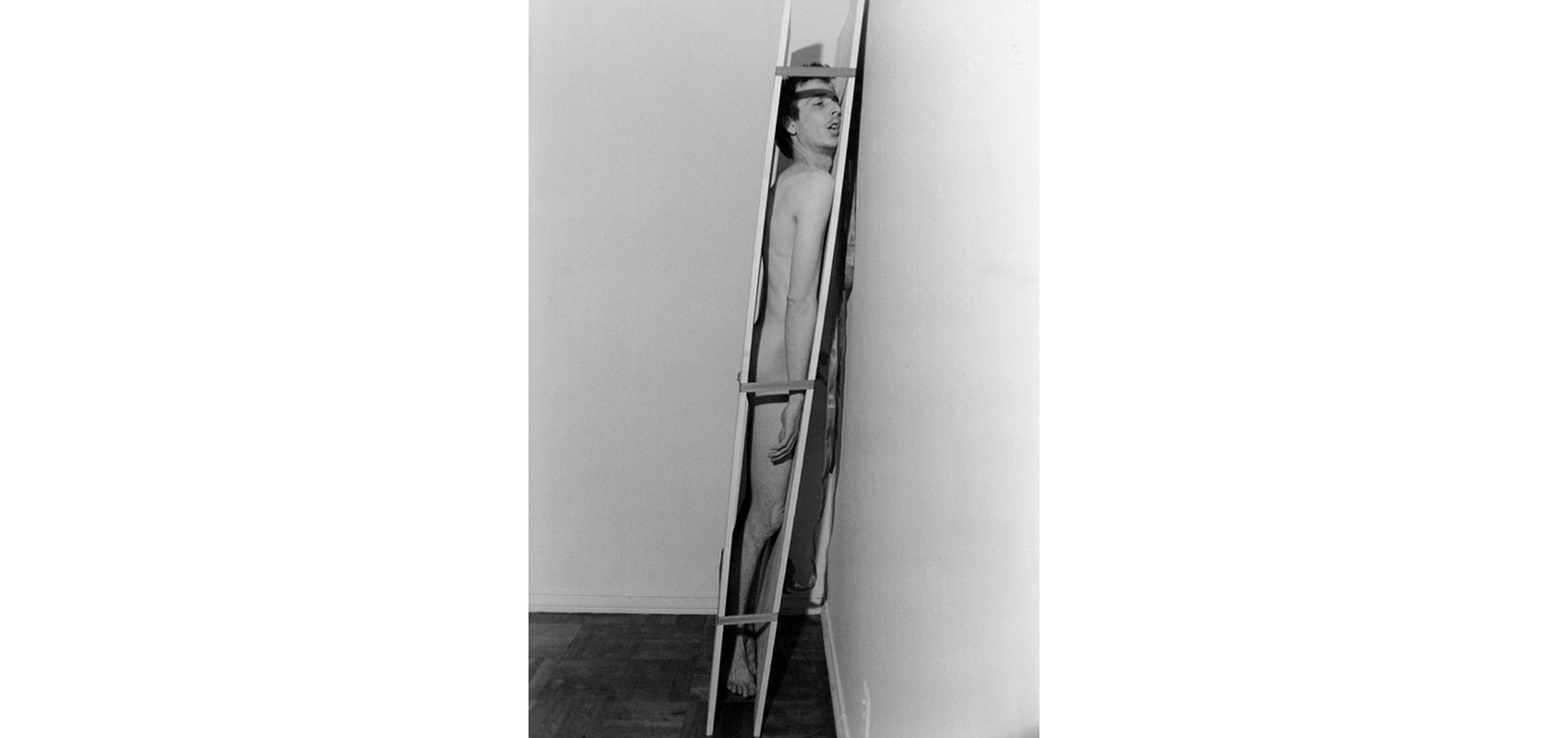 Closet Corner, Skip Arnold, 1987. Image courtesy of the artist.
Closet Corner, Skip Arnold, 1987. Image courtesy of the artist.
Franko B
Franko B is an extraordinary artist who has been making drawings, installations, sculptures, and performances for over 30 years. Curator Becky Haghpanah-Shirwan describes his work and life as “situated somewhere between isolation and seduction, benevolence and confrontation, suffering and eroticism, punk and poetry. It is a certain type of schizophrenia that finds a balance, dramatically undermining the status quo.”
In Aktion 398 (1998-2002), audiences engaged in a one-to-one confrontation with Franko B. Taking a numbered ticket, audiences waited to be led individually into a specially constructed room where they encountered Franko sat against a wall, painted white, wearing a human-sized recovery collar and bleeding from a cut in his abdomen.
LADA has worked with Franko since we launched in 1999, including a presentation of his I Miss You! In the Turbine Hall at Tate Modern as part of our Live Culture programme in 2003. In 2018, LADA published Franko’s memoir Because of Love and, in 2016, screened Nathaniel Walter’s film of the same name. Artist Andrea Pagnes has written a text in response to Because of Love. Franko has been published considerably, and there are extensive critical reflections on his life and work available online. In 2018, the University of Bristol Theatre Collection acquired Franko’s archive. Writers Maddy Costa and Mary Paterson reflected on and responded creatively to challenges presented by the collection as it went through the archival process, contributing blog posts on the Theatre Collection Blog and a small publication – Challenging Archives – to mark the end of the project.
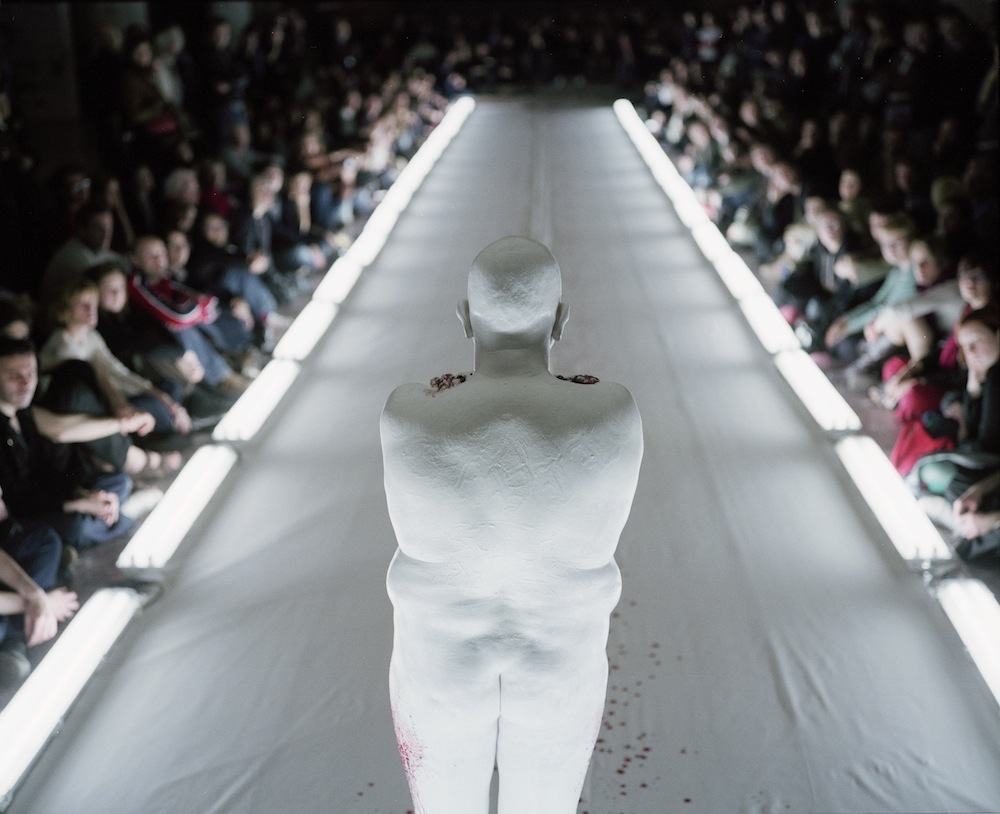 Franko B, "I Miss You!", at Live Culture, Tate Modern, 2003. Photograph: Hugo Glendinning.
Franko B, "I Miss You!", at Live Culture, Tate Modern, 2003. Photograph: Hugo Glendinning.
Joseph Beuys
In Beuy’s 1974 action I Like America and America Likes Me, the artist flew to New York and was taken from the plane on a stretcher to a gallery in Manhattan where he lived with a coyote for three days, before returning by stretcher to a plane, his feet never touching American soil. The work intervened in multiple American national myths and processes of cultural forgetting. Seeking to reckon with the coyote, Beuys claimed he sought to lift the trauma of the schism between indigenous knowledge and the mechanistic, materialistic values of the settler-colonial project.
Beuys is considered an instrumental figure in the development of performance art and a multitude of interviews, essays, critical reflections are available online, including documentation of this performance. LADA included I Like America and America Likes Me in the screening programme of Animals of Manchester (including Humanz) for Manchester International Festival in 2019.
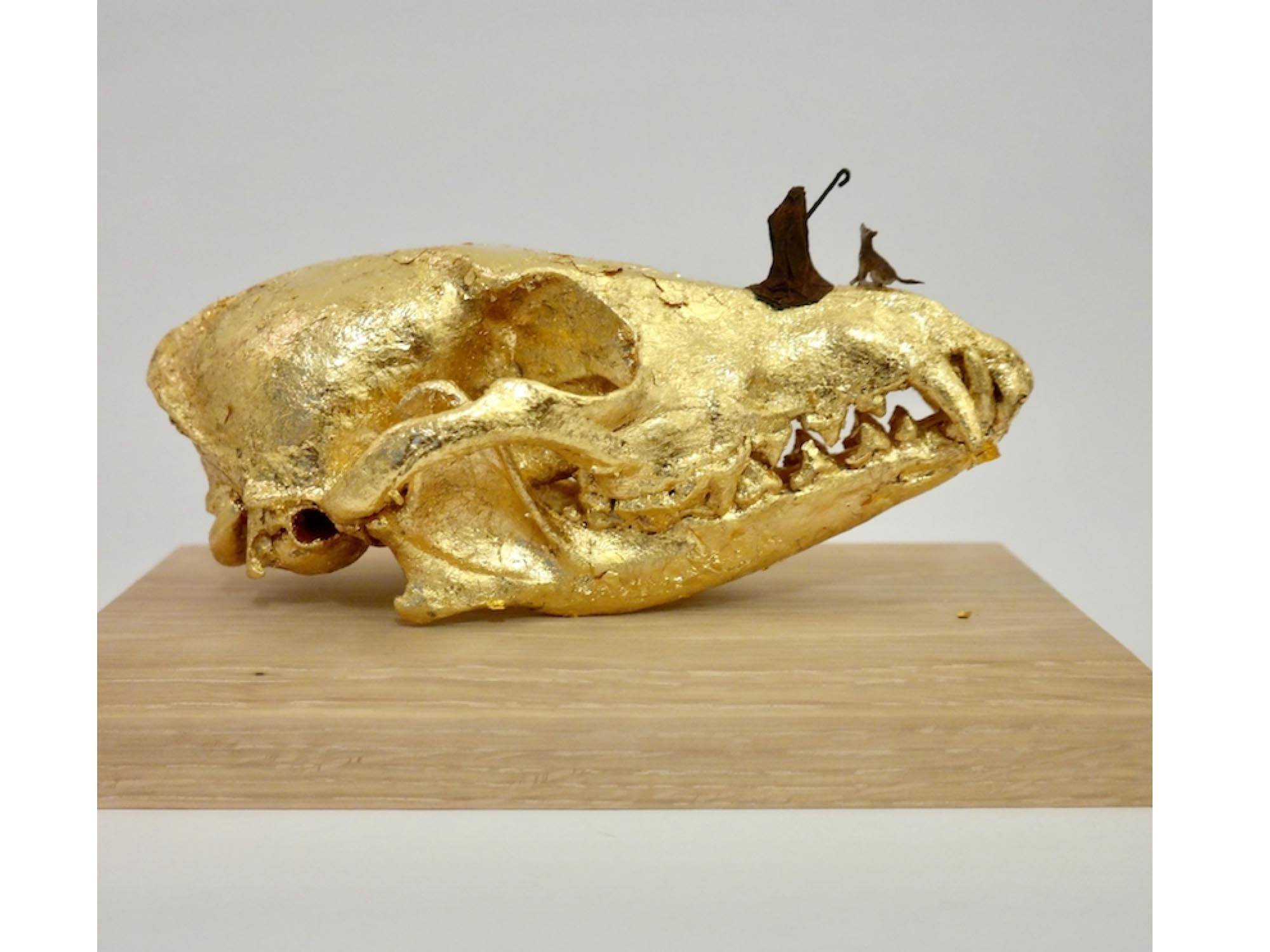 Tiny Live Art (Development Agency) by Robert Daniels, featuring Joseph Beuys, I like America and America Likes Me
Tiny Live Art (Development Agency) by Robert Daniels, featuring Joseph Beuys, I like America and America Likes Me
Brian Lobel
Warmly nostalgic, BINGE is a performance installation curated by artist Brian Lobel, who works through installation, stage shows, cabaret, interactive performance and publishing to consider interpersonal relations, intimacy, illness, technology, nationalism, economy and sexuality. Through a series of one-to-one drop in performances, a performer prescribes audiences an episode of a certain box-set, relating to answers they gave to a pre-performance questionnaire. They watch this episode in bed accompanied by the performer.
There are videos and documentation of BINGE on Brian’s website. Brian has led LADA DIY project and contributed to a number of LAD programmes over the years including Access All Areas in 2011. LADA published his DVD CANCER CANCER CANCER CANCER CANCER in 2012.
 Naana Mora and Brian Lobel, Come Dine With Me, Channel 4. Image courtesy of the artists.
Naana Mora and Brian Lobel, Come Dine With Me, Channel 4. Image courtesy of the artists.
Bruce Nauman
In the late 1960s, having graduated from art school, artist Bruce Nauman produced a series of performances to camera in which he paced through his studio, performing mundane actions with varying rhythms. Nauman often demarcated an area of his studio with tape, remaining confined in this space for the duration of the performance.
Tate have published a paper by Ruth Burgon entitled Pacing the Cell: Walking and Productivity in the Work of Bruce Nauman which reflects critically on the works in relation to Foucault’s Discipline and Punish.
Harry Clayton-Wright
The Slumber Party is a performance installation by artist and entertainer Harry Clayton-Wright, first presented at Glastonbury Festival in 2015. Adopting the persona of Rebecca Xanthe Pollard, a politically indifferent but glamorous teenager, Clayton-Wright spent the entire festival (107 hours) locked in Rebecca’s ‘bedroom’ as a protest against protest.
There’s more information about the work and a film of the Glastonbury performance, entitled 107 Hours, on Harry’s website, and in this article from the Guardian.
Banner image credit:
Out of Now, The Lifeworks of Teching Hsieh, Ed. Adrian Heathfield, 2009
Part of Lockdown Lists
LADA is compiling a series of reference lists of writings and films which draw attention to examples of historic and contemporary Live Art practice that or speak to some of the experiences of lockdown or issues a lockdown raises.
Lockdown Lists
LADA is compiling a series of reference lists of writings and films which draw attention to examples of historic and contemporary Live Art practice that or speak to some of the experiences of lockdown or issues a lockdown raises.
Read moreLive Art and Time
This Lockdown List considers ways in which artists have worked with time.
Read moreThe Live Art Almanac Volume 6
This Lockdown List is a reimagined Volume 6 of the The Live Art Almanac, LADA’s ongoing publishing project focused on collecting and disseminating ‘found’ writing about Live Art.
Read more